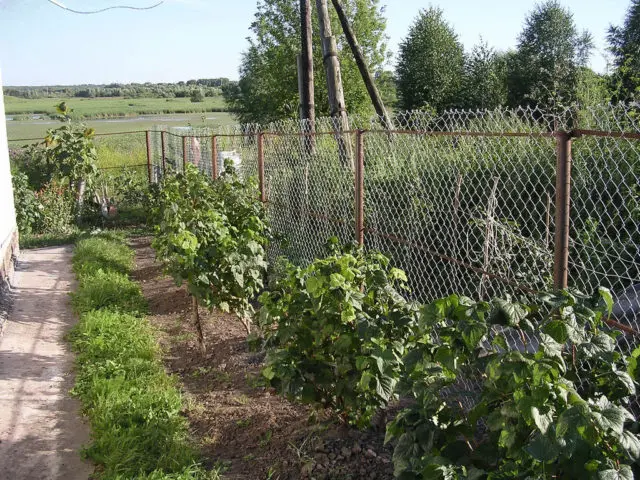Contents
Blackcurrant is often planted in summer cottages or household plots. This shrub is known for its unpretentiousness and stable fruiting. Currants can tolerate low temperatures and short periods of drought. One of the problems with growing is the yellowing of the leaves. When blackcurrants turn yellow or react to growing conditions with leaf drop, it is important to find the causes of such problems in order to find ways to deal with the problem in a timely manner.
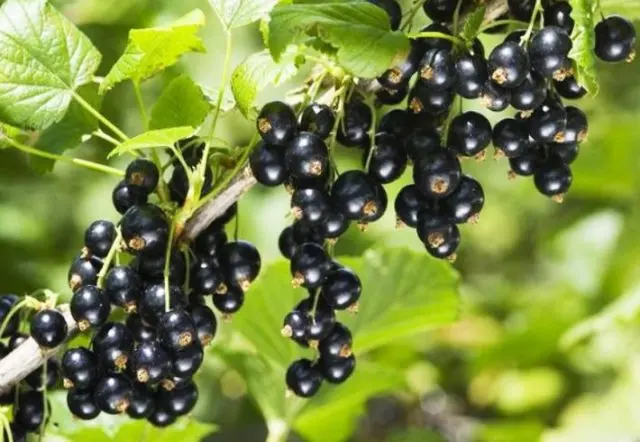
Why do currant leaves turn yellow?
Currant leaves may turn yellow in spring, autumn or summer. Each of the cases can be triggered by different reasons. In addition, blackcurrants turn yellow due to the appearance of several factors at the same time.
The main task of gardeners is to find the reasons why yellow spots appear on currant leaves. Agricultural technicians and experienced gardeners identify several main factors why the leaves turn yellow. Each of them needs to be considered in more detail.
Improper care
After planting the seedlings, an equally important period of care for the growing bush begins. During this time, an irrigation schedule is established, and shortcomings are found in preparing a seat or when choosing a site for planting. If violations are made to one of the points, then the currant may react by turning yellow its leaf plates.
When leaving, they adhere to the basic rules for planting and caring for blackcurrant seedlings:
- The area where the culture grows should be flat, well lit. An exception is landing on the path of through winds. The best option for blackcurrants is considered to be places along fences and hedges with the necessary indentation for growth. When planting, about 1,5 – 2 m is left between seedlings. A smaller distance can lead to a weakening of the root system due to the inability to grow sufficiently in breadth under the top layer of soil. The choice of a darkened area, under the crowns of tall deciduous trees, leads to the withering of the currant leaf plates, the weakening of the shoots that have appeared, and the shrinkage of the fruit. Blackcurrant is a crop that loves the sun. If during its development on the plot there was a change of plantings around or a building was built blocking the sun, then it will not be possible to avoid the fact that the leaves of the shrub turn yellow;

- One of the violations of care may be the neglect of the rules of watering. Blackcurrant responds with yellowing leaves to insufficient moisture or excessive moisture stagnation. During the period of flowering and fruiting, blackcurrants are watered 2 times a week. For each adult bush, 1 bucket of warm water is allocated. Planting blackcurrant in the lowlands, where possible stagnant water leads to rotting of the root system, provokes a change in the color and structure of the leaves. As a result, the leaves turn yellow;
- Top dressing is an important point that must be observed when caring for blackcurrants. As a rule, the appearance of yellow spots on the leaves in the absence of fertilizer indicates a lack of nitrogen. This element is responsible for the growth of green mass, the structure of leaf plates, their rich color. During the fruiting period, currant leaves begin to turn yellow if the fruits do not have enough potassium and phosphorus. Fruit formation begins to take all the strength from the leaf plates, shoots and roots: thus, the fruits remain large, and the leaves begin to turn yellow;
- Loosening, mulching, caring for the trunk circle. Many owners do not attach importance to cleaning the areas around the trunk. At the same time, they follow the rules of watering and fertilizing, spraying plants, cutting and processing them. Lack of mulching can lead to active moisture loss during dry summers or the spread of weeds around the trunks, which prevents the root system from getting enough nutrients from the soil. Insect pests often breed on weeds, which can spread to currants and ruin the crop.
Adverse weather conditions
The leaves turn yellow due to the high air temperature in summer in the absence of sufficient watering. In addition, early frosts in autumn can provoke yellowing. This type of yellowing is determined by the degree of localization:
- during drought, the leaf plates turn yellow at the edges;
- when frosts, yellowing affects only the tips.
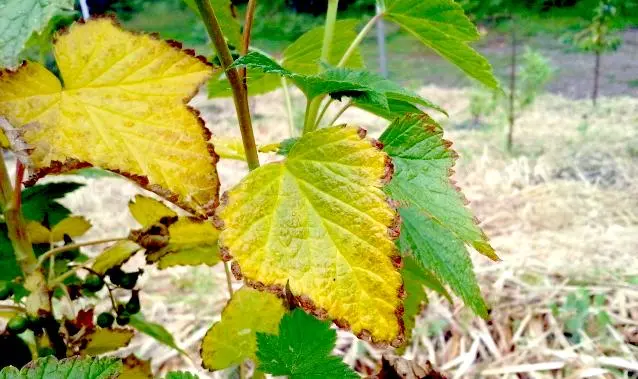
Diseases
Many blackcurrant diseases, in which its leaves turn yellow, can be triggered by care errors. Diseases overtake culture for other reasons. Breeding varieties are maximally protected from the anthracnose disease, which is common for currants. However, this disease is still the most dangerous for blackcurrant bushes. In addition, powdery mildew often develops on blackcurrants, and they can also be affected by double, rust or blotch. In these cases, currant leaves are covered with yellow dots.
Antraknoz
The most common fungal disease among different varieties of blackcurrant. It begins with the appearance of yellow spots on the leaf plates, then the yellow spots actively turn brown, and the damaged areas of blackcurrant leaves completely discolor. After that, anthracnose gradually affects the petioles, as a result of which the leaves fall off or, remaining on the shoots, begin to turn yellow and rot.
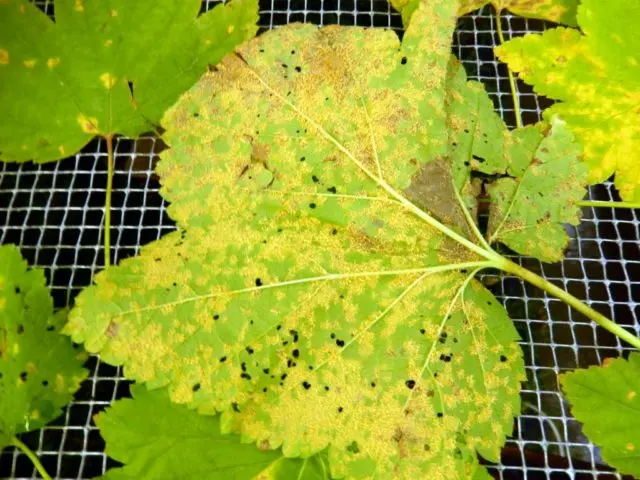
Makhrovost
This disease is associated with a concomitant factor in the appearance of spider mites. He is considered a carrier of the virus. At an early stage, it is quite difficult to detect terry. When severe symptoms appear, it is not often possible to save the culture. The main signs by which terry can be diagnosed:
- inflorescences acquire a purple hue and terry structure;
- leaves on blackcurrant turn yellow, stretch;
- berries are prone to shrinking and falling off.
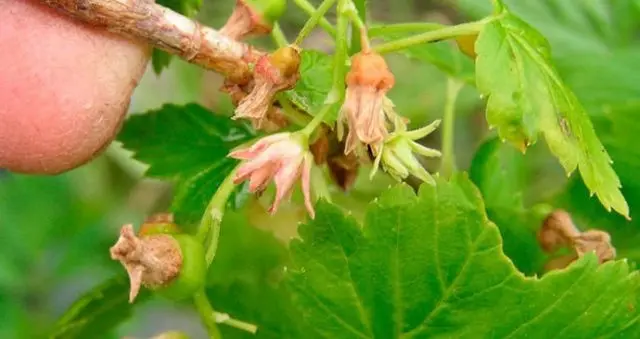
Spheroteka
A dangerous fungal disease, which is characterized by the appearance of a white coating on different parts of the plant. The affected areas of blackcurrant leaves begin to gradually turn yellow, then dry out and curl. Educated fruits do not have time to ripen. In addition, a concomitant factor may be the appearance of yellow dots on the currant leaves, which darken over time and acquire a black tint. When a sphere library is found, blackcurrants are treated with special substances.

Rust
A fungal virus that infects leaf blades. The leaves begin to turn yellow, orange pads may develop on the underside of them at the same time. White dots appear on the formed berries. Fruits are forbidden to collect and eat. By the time the crop should produce a crop, the leaves turn completely yellow and fly around, leaving bare shoots. In this case, the formation of shoots is completely stopped.
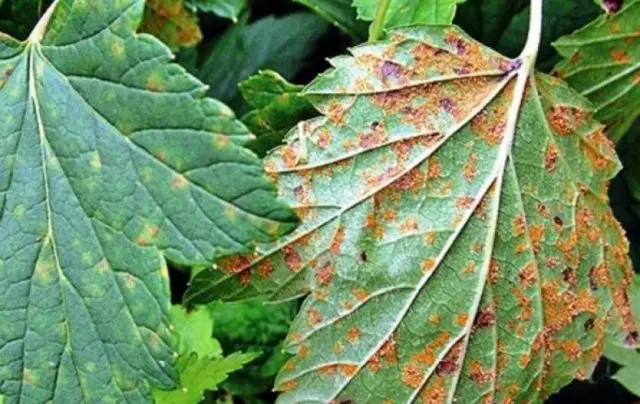
vermin
Insects attack blackcurrants in spring or after summer flowering. If the leaves of blackcurrants begin to turn yellow in May, then the cause should be sought on the inner surface of the leaf blades. Insects most often accumulate from below. In this way, they are protected from the scorching rays of the sun and are in close proximity to the veins of the leaf, through which cell sap flows, which is food for most pests.
gall aphid
One of the varieties of an extensive family of aphids. Most often, gall aphids can be found on red currants, but blackcurrant bushes also attract the parasite. One of the provoking factors for the spread of gall aphids on currant bushes is the planting of sage, oregano, mint or lavender near the bushes. These plants are often attacked by gall aphids, begin to turn yellow, and then the parasites spread to neighboring crops.
Outwardly, this is a small insect with an oval body shape. The color of the aphid is pale green, so the gall aphid is not easy to notice on the green surface of the leaves. A dry hot summer often becomes a provoking factor in the appearance of gall aphids. The individual is attached to the lower part of the currant leaves. The upper part of the plates begins to gradually turn yellow, then acquires a brown tint. This is due to the fact that the aphid sucks the cell sap from the plant, damaging all layers of the tissue. After feeding, a gall aphid colony can leave the culture together, spreading to neighboring shrubs. By this time, the currant bushes will be weakened, the leaves will continue to change shade and structure. Processes can lead to underripe fruits. To combat aphids, phased treatments are carried out, thanks to which it is possible to get rid of adults and the remaining clutches.
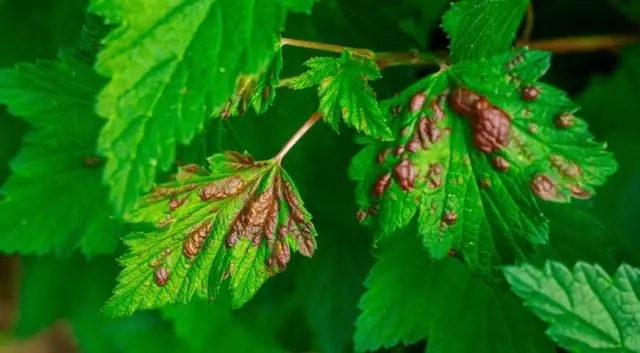
spider mite
The appearance of an insect is one of the reasons that blackcurrants begin to turn yellow and dry out. Ticks feed on cell sap, depriving the bushes of vitality, and also entangle the shoots with a sticky white web that prevents development. The leaves on the blackcurrant, covered with cobwebs, gradually turn yellow. You can get rid of the insect after several phased treatments.
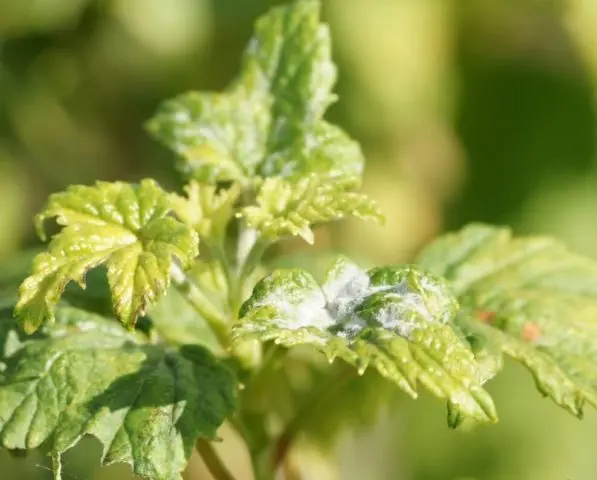
currant glass jar
This insect is able to hide on blackcurrant for quite a long time. The leaves of the shrub, when a glass case appears, begin to turn yellow from the place of attachment to the center, then they dry out and become a habitat for butterfly larvae. The insect lays up to 100 eggs daily, the larvae are located inside the stem. When spreading glassware, gardeners are advised to get rid of the affected parts of the currant bush and carefully process the uninfected part.
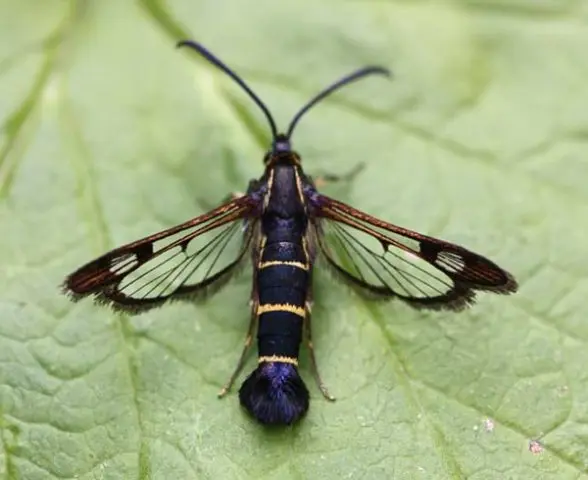
What to do if currant leaves turn yellow
When the blackcurrant shrub begins to fade, the leaves become covered with yellow veins or dots, gardeners recommend eliminating provoking factors by changing the approach to caring for the plant. The treatment of bushes that have begun to turn yellow helps well with special means for curing and getting rid of pests.
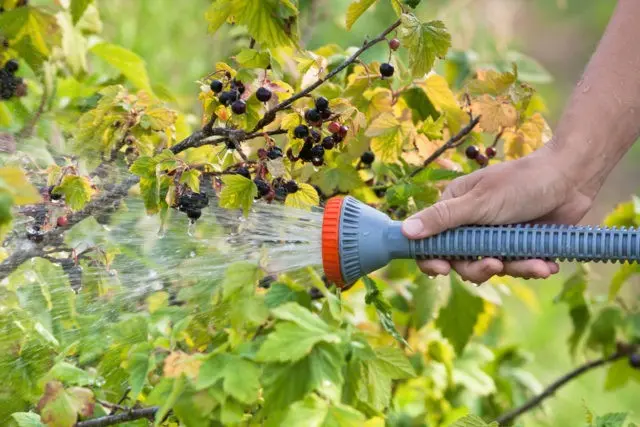
Chemical biological agents
When the currant turns yellow, a variety of means are used. The appearance of fungal diseases, as well as the spread of insects, which peaks in the spring, require a different approach. Blackcurrant treatments with chemical or biological agents are carried out in spring and summer.
Prophylactin
It is a concentrated oil emulsion that consists of an insecticide. This is a chemical preparation that is specifically designed to kill pests. It belongs to one of the types of disinfection and is used before the period of swelling of the kidneys. The mechanism of action of a chemical preparation is based on its penetration into the plant and distribution through the tissues. Prophylactin protects the root system, resulting shoots, leaf plates and flowers from the appearance of pests. For processing, use 1 vial of Prophylactin with a volume of 500 ml. This dose is dissolved in 10 liters of water and the bush is sprayed with a special garden sprayer.
Kleschevit, Aktofit
Represent the means by which blackcurrants are treated during the green leaf phase. This means that treatments are carried out after the appearance of the leaves. Spraying is subjected to shoots, leaf plates. Kleshchevit belongs to the type of acaricides, chemicals designed to combat and prevent ticks that can populate blackcurrant bushes. In addition, these preparations are suitable for eliminating the symptoms of powdery mildew. With the help of a sprayer in the spring, yellow small spots on currant leaves are purposefully sprayed.
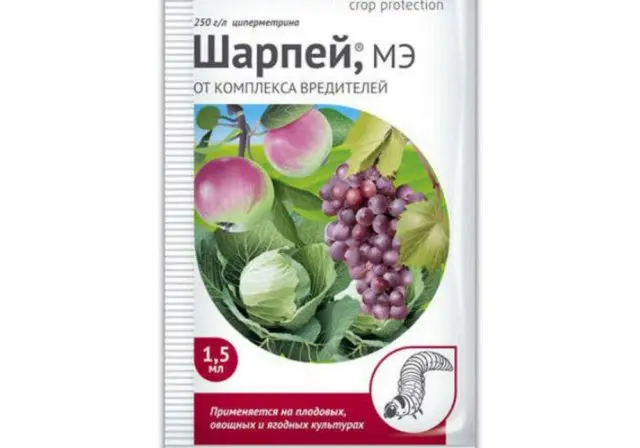
Iskra
Chemical insecticides such as Iskra and Iskra-M help protect currants from pests, provided they are processed in a timely manner. Use the period of time between the formation and growth of green foliage. Some varieties of Iskra preparations work well at air temperatures from +25 ° C, some analogues involve use at temperatures from +18 to +25 ° C. Chemical preparations of this group are produced on the basis of the active substance – malathion. The disadvantage of these funds lies in the fact that they are ineffective against pest clutches.
Oxykhom
It is a broad-spectrum biological preparation that:
- effective as a systemic contact fungicide;
- able to protect plants from diseases and pests;
- helps to cope with spotting, anthracnose, late blight;
- gets rid of ticks and caterpillars.
The crop is treated with the drug when the first signs of diseases or pests appear. Branches are sprayed, while windless days are chosen. Spray the agent with the condition of avoiding runoff of residues into the ground. Oksihom reaches its maximum effect on the third day after treatment, the effect lasts about 14 days.
Folk methods
Equally effective are options for mixtures prepared independently. If the leaves turn yellow on blackcurrants, experienced gardeners recommend treating them with solutions of onions, garlic, tar soap, and tobacco leaves.
Onion infusion
To prepare the mixture, take onion peel, insist in warm water for 15 hours. Then the infusion is filtered. The resulting liquid is sprayed with bushes, dry, calm days are chosen. The influence of onion infusions is due to the presence of phytoncides in the composition of the onion. They have antiparasitic effects, destroying spider mites and aphids.

Soap solutions
Widely known means based on shavings of household or tar soap. For their preparation, the chips are poured with boiling water, insisted for about 10 hours. Then they are diluted with water 1: 1. The resulting solution is sprayed with bushes. Means help get rid of most insects and destroy their egg laying.
tobacco solutions
In the spring, blackcurrants are treated with an infusion of tobacco leaves. For efficiency, laundry soap shavings are added to the solution. Tobacco dust, obtained after processing dry leaves, is used to powder leaf blades when the first signs of a disease or the presence of pests are detected.
Preventive measures
To prevent blackcurrant leaves from turning yellow in early spring or summer after fruit formation, gardeners recommend taking a number of preventive measures to help avoid problems.
Timely pruning of blackcurrant bushes is important when carrying out preventive measures. This method solves several tasks at the same time:
- forms a blackcurrant bush;
- eliminates the possibility of the appearance of fungus on damaged diseased branches that are to be removed;
- helps to prevent thickening of plantings, which often lead to the appearance of pests.
Sanitary pruning is carried out in early spring, after the plants emerge from wintering, and also in late autumn, in preparation for further sheltering of the bushes. Summer pruning is corrective.
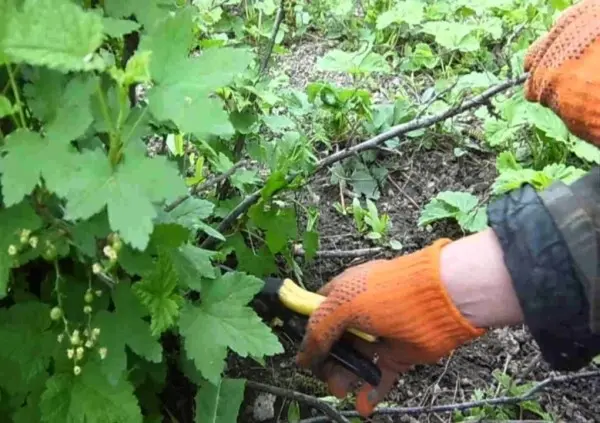
Around the blackcurrant bushes form a small near-trunk circle. This helps to properly mulch the soil around the trunk, as well as adjust the irrigation technique. One of the important preventive measures is the garter of bushes.
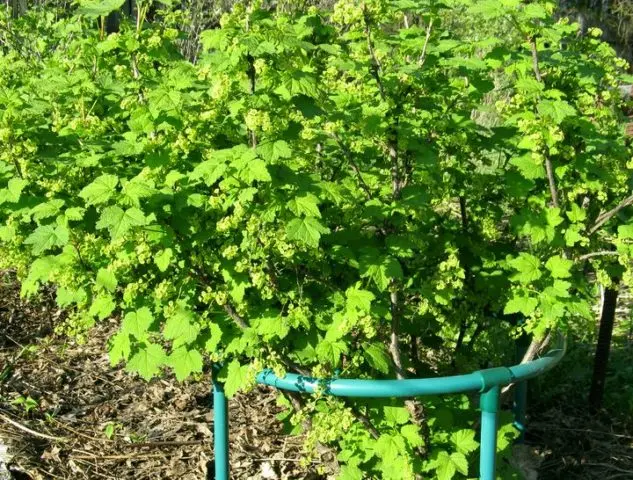
This applies to varieties with spreading lower branches to prevent them from falling to the ground. Supports are installed around the bushes and tied with ropes of synthetic nylon in a circle. The lower branches are laid on the rope, which become heavier after the appearance of berries.
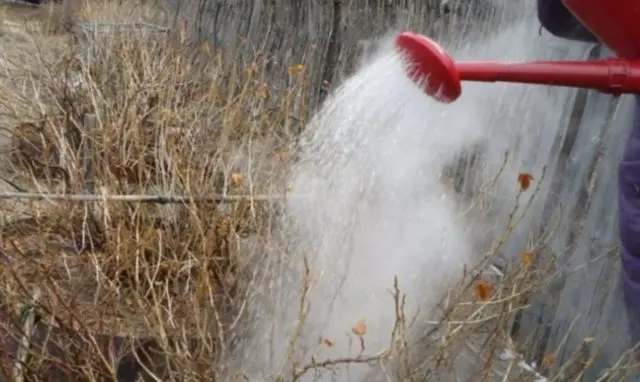
A good preventive measure against situations when the blackcurrant bush turns yellow is to warm the plant with boiling water in early spring. This method helps to eliminate the remnants of the fungus, particles of insects that have frozen out in winter, but remain on the branches. In addition, boiling water activates the flow of cell sap along the trunk, awakens plants.
Conclusion
When the blackcurrant turns yellow, it becomes clear that a disease develops on the shrub or insect pests appear. The main task of gardeners is to detect the cause of the yellowing of the leaves in time, to begin a systematic fight against it. Timely processing with the necessary means helps to cope with the problems that have arisen.










